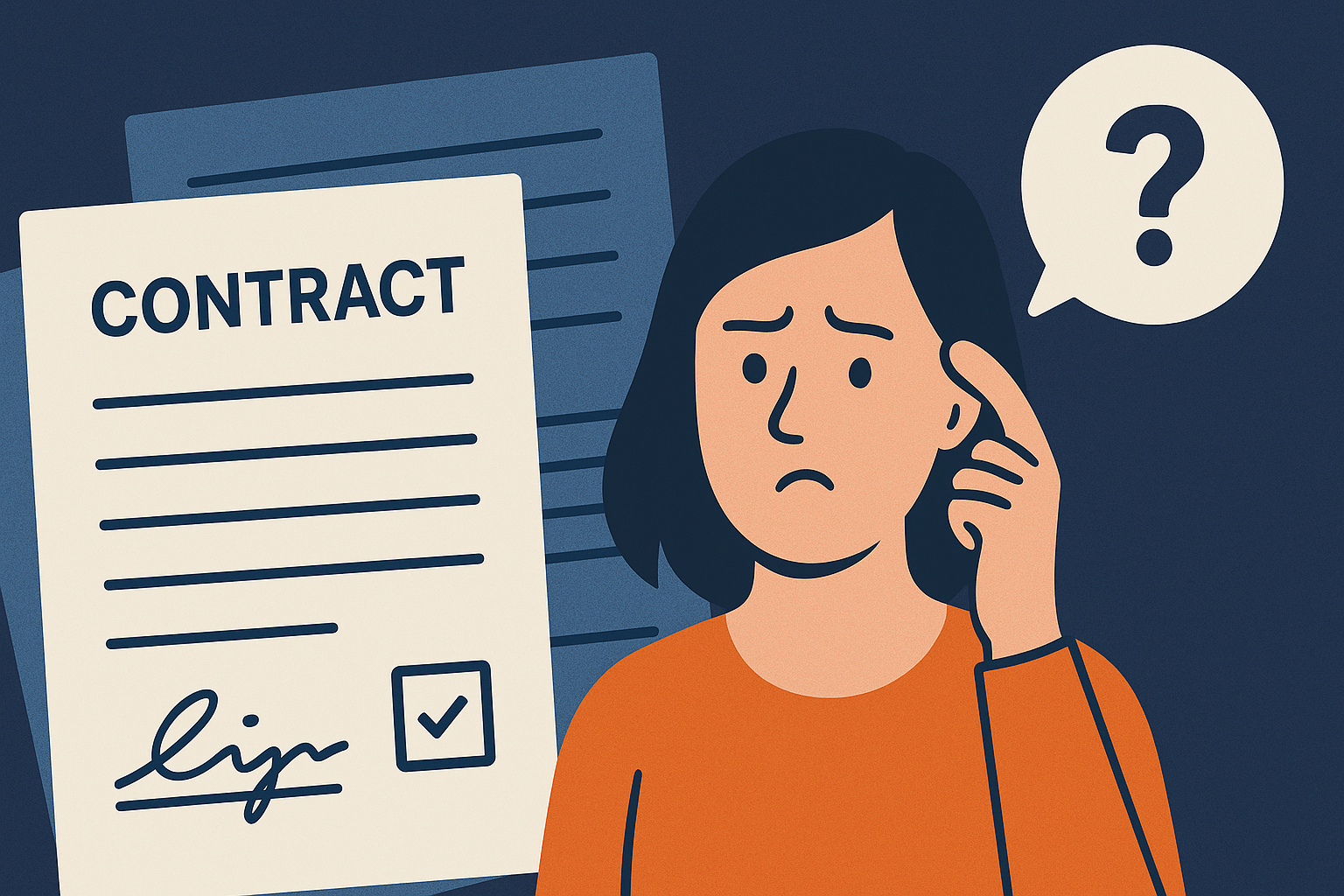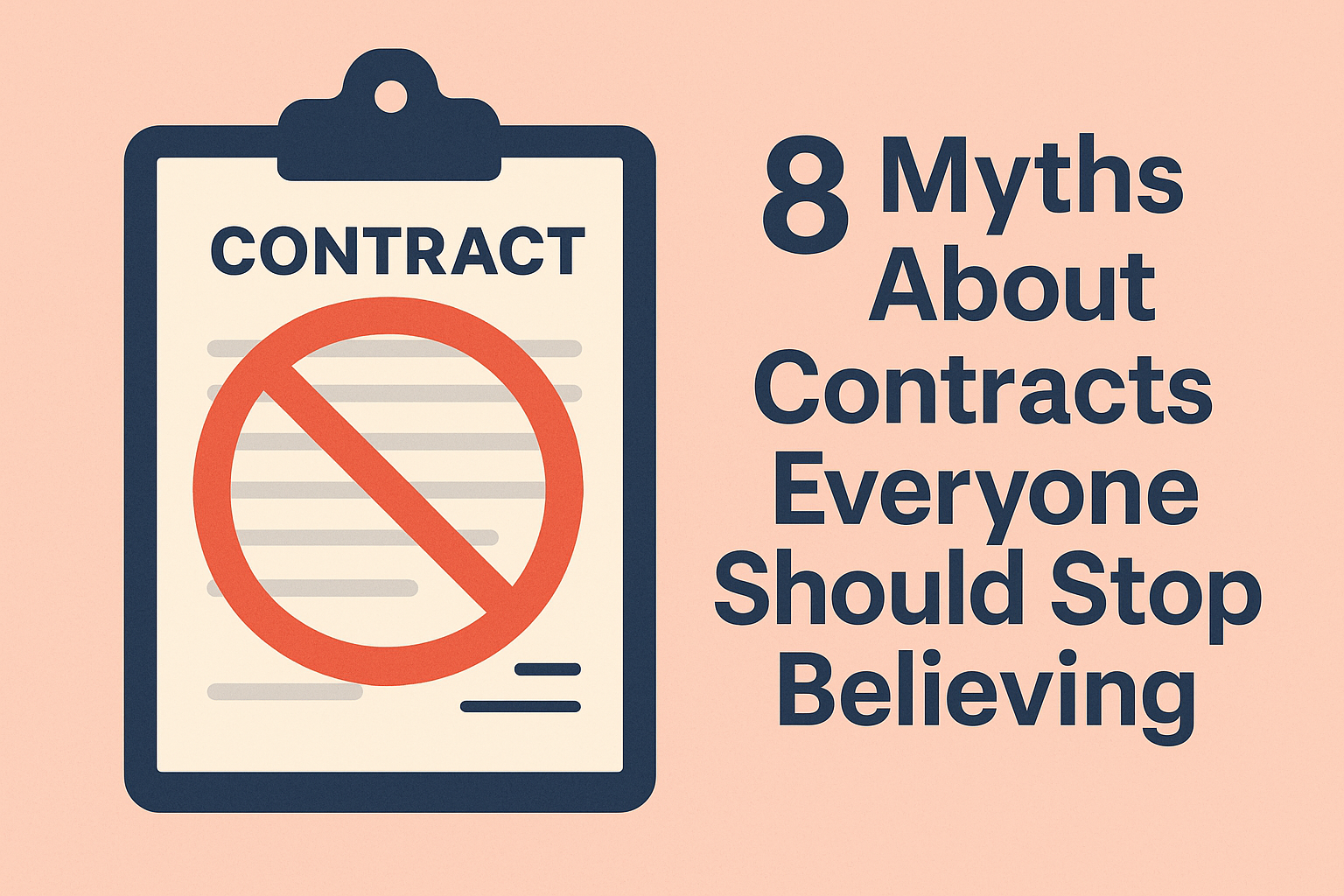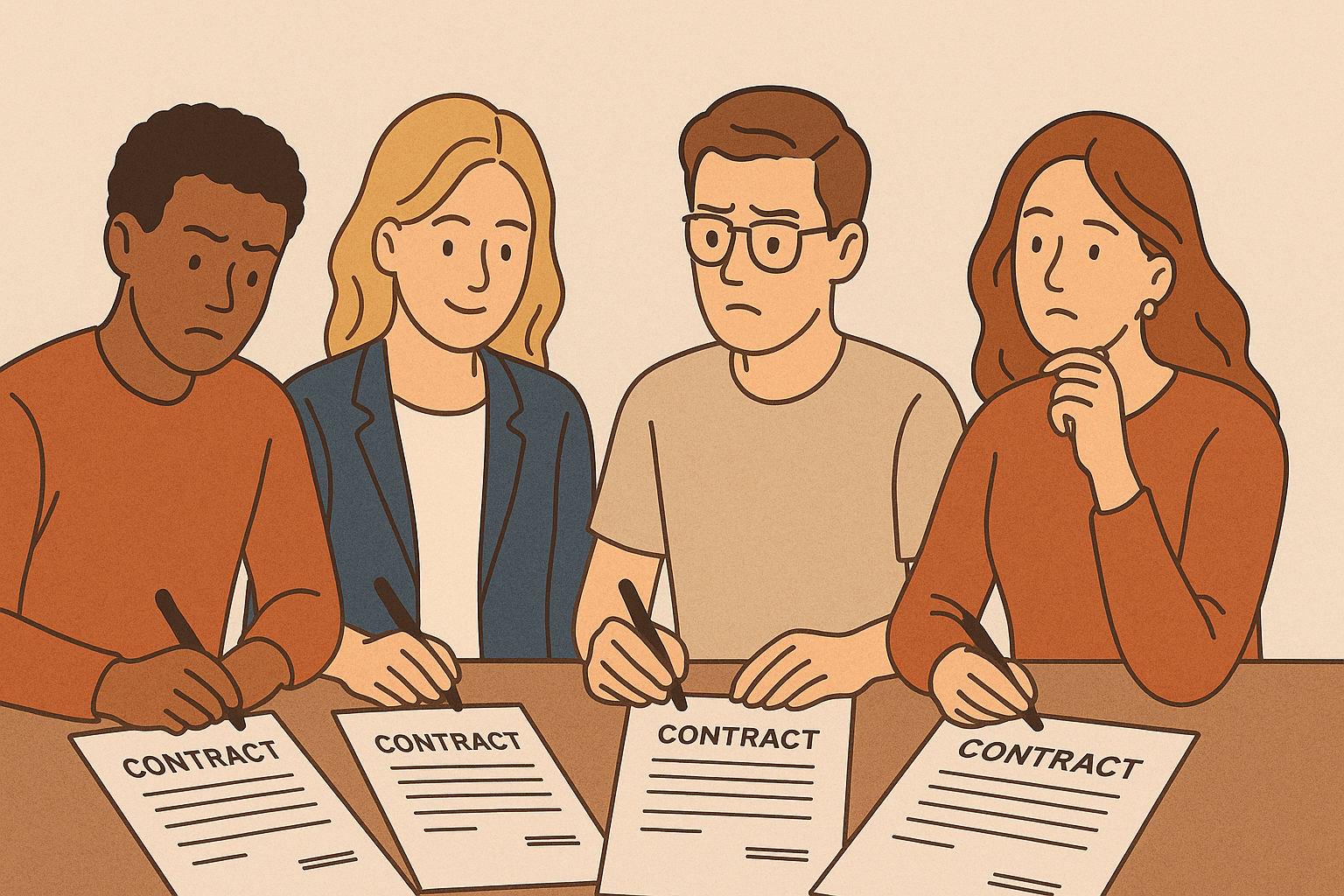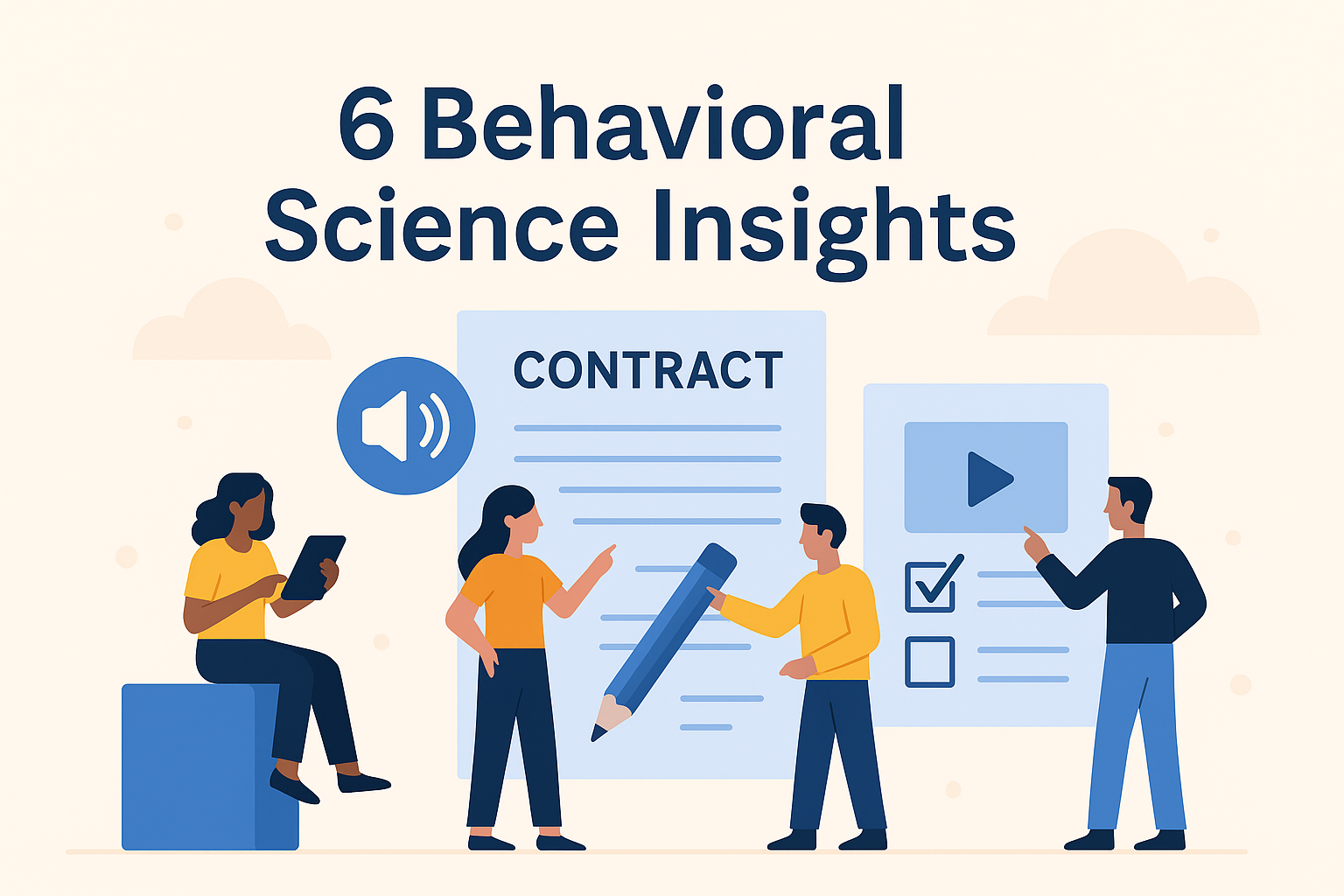Many people sign contracts without truly understanding them – a risky practice that today’s electronic signature tools do little to prevent. In this blog, we explore how common this problem is, why it happens, and the hidden dangers of agreements your clients don’t actually comprehend. We’ll also look at why traditional e‑signature platforms fall short on ensuring understanding, and how a new approach can help capture real informed consent.
In this blog, we’ll explore:
- Signing Without Understanding: A Widespread Issue
- Why People Don’t Read Before Signing
- The Risks of Misunderstood Agreements
- E‑Signature Tools and the Comprehension Gap
- Beyond Signatures – Toward Informed Consent
- Conclusion
Signing Without Understanding: A Widespread Issue
It’s an open secret that most people don’t fully read contracts or terms before agreeing. A Deloitte survey found that 91% of consumers consent to legal terms and conditions without reading a word. In one academic experiment, 98% of participants even agreed to give up their first-born child in a fake terms-of-service – simply because they didn’t read the fine print. While that example was extreme, the takeaway is clear: we routinely sign things we haven’t actually digested.
This problem isn’t limited to click-through online terms. Even in important transactions, people often sign documents they don’t fully understand. According to a University of Law study in the UK, 68% of people either don’t read or don’t comprehend the contracts they sign for services like utilities or subscriptions. More than half admitted they skim agreements but don’t grasp everything they’re agreeing to. And about 13% confess they “hardly” or “never” read the contracts at all.
Real-world surveys by Adobe echo this trend. In one recent poll, 69% of consumers said they had signed a contract despite not knowing all the details. Two-thirds of those people later discovered unexpected terms in the agreement – with 15% calling those surprises “horrifying”. Small business owners fared no better: about 62% admitted signing without understanding everything, and most of them felt uncomfortable or fearful afterward. In larger organizations, around 61% of employees have signed work contracts they didn’t fully get, and nearly one-third later faced negative consequences on the job because of it3. The bottom line is that signing without reading is common across the board, from consumers to professionals.
Why People Don’t Read Before Signing
Why would intelligent clients agree to terms blind? There are several driving factors. One major reason is the sheer length and complexity of legal documents. Contracts and terms are infamous for dense “legalese” that the average person finds hard to penetrate. The Adobe survey noted that the top reason people skip reading is that contracts are simply too long and complicated3. In fact, many contracts are written at a reading level far above the general public’s literacy level. (Half of U.S. adults read below a 6th-grade level, yet legal documents are often far more advanced.) Faced with pages of jargon, many people give up and assume the important points are standard or benign.
Another reason is trust – or sometimes overconfidence. Clients might trust that the company or professional they’re dealing with wouldn’t give them an unreasonable contract, so they feel safe skipping the fine print. Alternatively, they’ve signed similar agreements before and assume they already know what’s in them. There’s also a sense of lack of choice: if you need the product or service, you might feel you have to click “I agree” or sign on the dotted line, no matter what the terms say. As one commenter quipped, “how many of us have just clicked yes to Apple’s terms and conditions without reading them? I rest my case.”
The digital age has made this even worse. Electronic signing has introduced new speed – but also new complacency. In the past, sitting with a paper contract at least signaled you should read it. Now, e‑signature workflows often encourage a quick scroll to the bottom. People routinely sign multiple documents in one go, especially during big transactions like home purchases or loan closings where dozens of forms are presented together. It’s not uncommon for a real estate closing to involve 100+ pages of contracts and disclosures, which few buyers can realistically absorb on the spot. The convenience of e‑signing – from one-click “Accept All” buttons to bulk-signing capabilities – ironically makes it easier than ever to agree without reading. As a result, “signing blind” has become a reflex.
Alarmingly, even negative experiences don’t always change this behavior. A recent survey of Gen Z (young adults) found that over one-third of them never fully read the contracts they sign. Of those, 20% later realized they’d agreed to something they weren’t aware of, and 10% actually lost money for failing to read an agreement. You might think a scare like that would teach a lesson – yet 61% of those Gen Z respondents admitted they still don’t thoroughly read contracts afterward. This illustrates how deeply ingrained the habit of not reading is, even among those who should arguably be the most tech-savvy. In short, the pressure to move fast and the assumption that “it’s probably fine” often outweigh the vague fear of hidden terms.
The Risks of Misunderstood Agreements
Agreeing to terms you don’t understand isn’t just a bad habit – it’s a serious risk for both the signer and the organization on the other side. For individuals (your clients), the danger is obvious: they may be accepting obligations or waiving rights without realizing it. Later, when an issue arises, they could find they’ve boxed themselves in. For example, a client might sign up for a service and later object to a fee or a policy, only to learn that the contract allowed it. As a legal expert warns, if something goes awry – say, a surprise price increase – it’s very hard to challenge it if you already agreed to it in the contract’s terms. Likewise, if a client unknowingly breaches a rule in the contract, they could face fines or legal action that they never saw coming. In a very real sense, what you don’t know can hurt you.
On the business side, having clients who don’t understand the contract can lead to disputes, complaints, and reputational damage. Many customer complaints and even lawsuits stem from people later claiming they felt misled or didn’t truly consent to what they signed. If a customer or partner feels blindsided by terms buried in an agreement, they’re far less likely to trust your company – and far more likely to spread negative word-of-mouth or involve lawyers. Regulators are also paying closer attention to fairness in agreements. In sectors like finance and legal services, authorities now emphasize that it’s not enough to have a signed contract; the client should have reasonably understood it. If too many clients are confused or harmed by terms they “agreed” to, your process might be deemed unfair or non-compliant with consumer protection rules.
It’s worth noting that from a strict legal standpoint, a signature (or click) is usually binding regardless of actual comprehension. Courts have long held that a party is bound by a signed agreement even if they didn’t read it, as long as they had an opportunity to do so. In one case, an Uber driver tried to sue over a contract issue, only to be told that clicking “I agree” meant he was bound by the arbitration clause he failed to read. In general, claiming “I didn’t understand what I signed” is not a winning legal strategy absent fraud or deception. However, just because an unread contract is enforceable doesn’t mean it’s a good outcome. Clients who feel tricked or blindsided may still seek remedies through complaints to regulators or simply take their business elsewhere. And some courts and regulators are starting to scrutinize whether a company took steps to ensure clarity, especially for vulnerable customers. A signature alone won’t always shield you if the terms were fundamentally unfair or not explained – increasingly, there’s an expectation of informed consent, not just a formal signature.
Ultimately, misunderstood agreements create a lose-lose scenario. The client is at risk of unexpected obligations or losses, and the business faces potential fallout from disputes or compliance failures. It’s far better for everyone involved if the client actually knows what they’re signing. That way, the agreement truly reflects a meeting of minds, not just a one-sided formality.
E‑Signature Tools and the Comprehension Gap
Here’s where a big challenge lies: today’s popular e‑signature tools – think DocuSign, Adobe Sign, HelloSign, and the like – were built to collect signatures quickly, not to confirm understanding. They excel at the former and largely ignore the latter. In a typical e‑sign workflow, the recipient gets an email, clicks a link to open the document, and often can jump straight to the signature field. In just a few clicks, the document is signed and done. What’s missing is any evidence that the person actually read the content. As one analysis succinctly put it, an e‑signature only shows that someone clicked “sign” – it doesn’t show whether they read the document, whether they understood the key terms, or whether they know their rights and responsibilities under that contract. The platform records the act of signing, and that’s about it.
Most e‑signature platforms do not even attempt to gauge comprehension. They typically don’t track if you scrolled through every page, or if you opened links to any referenced terms, let alone whether you actually understood what you saw. At best, some systems might note how long a document was open before signing – but a client could leave it open while distracted, or scroll to the end immediately. There is usually no built-in quiz, acknowledgment of key points, or requirement to demonstrate understanding. It’s essentially an honor system: we assume if they signed, they must have agreed with full knowledge. In reality, as we’ve seen, they might have just scrolled to the end and clicked because it was convenient.
This gap leaves organizations vulnerable. If later a client says “I didn’t actually read that part, I had no idea,” the audit trail from a typical e‑sign tool won’t help you much. It will show the timestamp and the signature, but not whether the client was informed. As one industry blog notes, if a client later claims lack of understanding, your standard e-signature audit log may not support you at all. Regulators could view a simple click-to-sign process as superficial, prioritizing speed over fairness. And if a dispute arises, it becomes a he-said/she-said debate because there’s no proof of what the client actually comprehended.
The design of traditional e‑sign tools, while great for efficiency, can unintentionally encourage careless signing. Features like “bulk signing” (where someone can apply one signature to many documents at once) save time but also reduce the likelihood that each document gets the attention it deserves. Likewise, the UX pattern of highlighting signature and initial fields can lead recipients to focus only on those required clicks, mentally skipping over the rest. As an illustration, the official  i agree compare page poses some critical questions e‑signatures can’t answer:
i agree compare page poses some critical questions e‑signatures can’t answer:
- Did the user notice the cancellation clause?
- Were the fees clear? Would they be able to recall what they agreed to later, or did they just scroll and click?
- Were the fees clear? Would they be able to recall what they agreed to later, or did they just scroll and click?
If you suspect the honest answer to most of those is “they probably just clicked,” then you understand the flaw. A signature alone cannot tell you if your client actually understood the agreement – and most e‑sign platforms won’t tell you, because they simply have no data on comprehension.
Beyond Signatures – Toward Informed Consent
So, what’s the solution? If the traditional tools don’t capture understanding, businesses need to go beyond the signature to make sure clients are truly informed. The concept gaining traction is “informed consent” in contract acceptance – essentially adapting the idea from healthcare and research (where informed consent is critical) to everyday business agreements. An informed consent approach means the client doesn’t just sign; they actively demonstrate that they understand the key terms. This could involve simplifying language, using summaries, asking the client to confirm particular points, or other measures to ensure clarity.
In fact, regulators are increasingly expecting exactly this kind of effort. Financial regulators like the UK’s Financial Conduct Authority now require firms to aim for “good outcomes” for customers – which includes customers comprehending the products and terms. Legal regulators (such as the Solicitors Regulation Authority in England) mandate that lawyers explain things in a way clients can understand. Data privacy laws (GDPR and others) demand that consent be informed and freely given, not just a formality. All these trends point to a simple truth: a signed PDF isn’t enough anymore, you may need evidence that your client was informed and understood.
This is where new contract clarity tools are emerging. One such platform,  i agree, is built specifically to ensure and document comprehension, not just capture a quick signature. (Disclosure:
i agree, is built specifically to ensure and document comprehension, not just capture a quick signature. (Disclosure:  i agree is the company behind this blog, and its name appears in bold throughout.) The
i agree is the company behind this blog, and its name appears in bold throughout.) The  i agree system takes a “consent-first” approach: instead of treating the signature as the be-all end-all, it breaks the agreement process into steps designed for understanding. For example, a contract can be presented in clear sections with plain-language summaries for each part. There may be short explainer videos or audio that walk the client through the important points in a more digestible way. The client is given opportunities to ask questions and get answers before finalizing the deal. Finally, instead of a traditional signature, the client might record a brief confirmation – such as repeating key terms or stating their consent out loud – which is then saved as part of the audit trail.
i agree system takes a “consent-first” approach: instead of treating the signature as the be-all end-all, it breaks the agreement process into steps designed for understanding. For example, a contract can be presented in clear sections with plain-language summaries for each part. There may be short explainer videos or audio that walk the client through the important points in a more digestible way. The client is given opportunities to ask questions and get answers before finalizing the deal. Finally, instead of a traditional signature, the client might record a brief confirmation – such as repeating key terms or stating their consent out loud – which is then saved as part of the audit trail.
The end result is a record of agreement that includes proof of understanding. For instance,  i agree produces a secure audit trail showing exactly what information was presented to the client (including the video or summaries), what the client did (such as viewing each section, acknowledging key points, and providing a voice confirmation), and that they affirmed their understanding. This goes well beyond a checkbox or a hurried e‑signature. It creates an evidence-backed story of informed consent. If later anyone questions whether the client knew what they were signing, you can point to a recorded process demonstrating that they did.
i agree produces a secure audit trail showing exactly what information was presented to the client (including the video or summaries), what the client did (such as viewing each section, acknowledging key points, and providing a voice confirmation), and that they affirmed their understanding. This goes well beyond a checkbox or a hurried e‑signature. It creates an evidence-backed story of informed consent. If later anyone questions whether the client knew what they were signing, you can point to a recorded process demonstrating that they did.
Importantly, approaches like this aim to be user-friendly, not cumbersome. They seek to make the experience easier for clients of all literacy levels by using visuals, audio, and straightforward language. As a bonus, clients often appreciate the transparency – it feels like the company wants them to truly understand, which builds trust. It’s a shift from the old “gotcha” contracts towards more ethical, clear agreements.
For those worried about legality: informed-consent platforms still result in a legally binding agreement, just with more robust documentation. Electronic signatures can be replaced by secure digital “seals” or confirmations that meet the requirements of e-signature laws while capturing much richer context. (See our legal compliance page for how  i agree aligns with eIDAS, ESIGN, UETA and other laws.) In short, you don’t lose any legal enforceability – you gain assurance that the consent was real. The comparison between
i agree aligns with eIDAS, ESIGN, UETA and other laws.) In short, you don’t lose any legal enforceability – you gain assurance that the consent was real. The comparison between  i agree and traditional e‑sign tools> makes it clear: while e‑signatures capture only a quick “yes,” a consent-first system captures understanding, intent, and agreement in one package.
i agree and traditional e‑sign tools> makes it clear: while e‑signatures capture only a quick “yes,” a consent-first system captures understanding, intent, and agreement in one package.
Conclusion
In an era where signing has become as easy as clicking a button, it’s more crucial than ever to ask: do our clients actually know what they’re saying yes to? If most people are agreeing to contracts they haven’t read or don’t understand, we have a problem – one that can lead to unhappy customers, legal disputes, and regulatory headaches. Traditional e‑signature tools, for all their convenience, won’t alert you to a comprehension gap. They’ll happily collect a signature from a client who is utterly in the dark, and give you no warning about it.
The good news is that awareness of this issue is rising, and so are solutions. By moving toward processes that promote clarity and verify understanding, you can protect your clients and your business at the same time. Think of it as upgrading from a mere “signature” to true consent. Regulators are beginning to expect it, and clients certainly deserve it. After all, a contract should be a mutual agreement – not a mystery document one side silently endures.
As the saying goes, an agreement isn’t really “agreed” unless it’s understood. It’s time to bridge the comprehension gap. Whether you use a platform like  i agree or adopt your own measures, ensure that when your client signs on the line, they know exactly what it means. Your contracts will be stronger, your compliance easier, and your client relationships built on trust rather than uncertainty. In the long run, informed clients are happier clients – and that’s a win-win outcome every business should be aiming for.
i agree or adopt your own measures, ensure that when your client signs on the line, they know exactly what it means. Your contracts will be stronger, your compliance easier, and your client relationships built on trust rather than uncertainty. In the long run, informed clients are happier clients – and that’s a win-win outcome every business should be aiming for.




